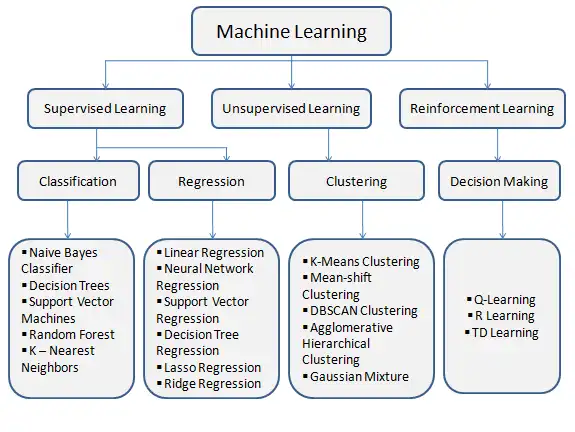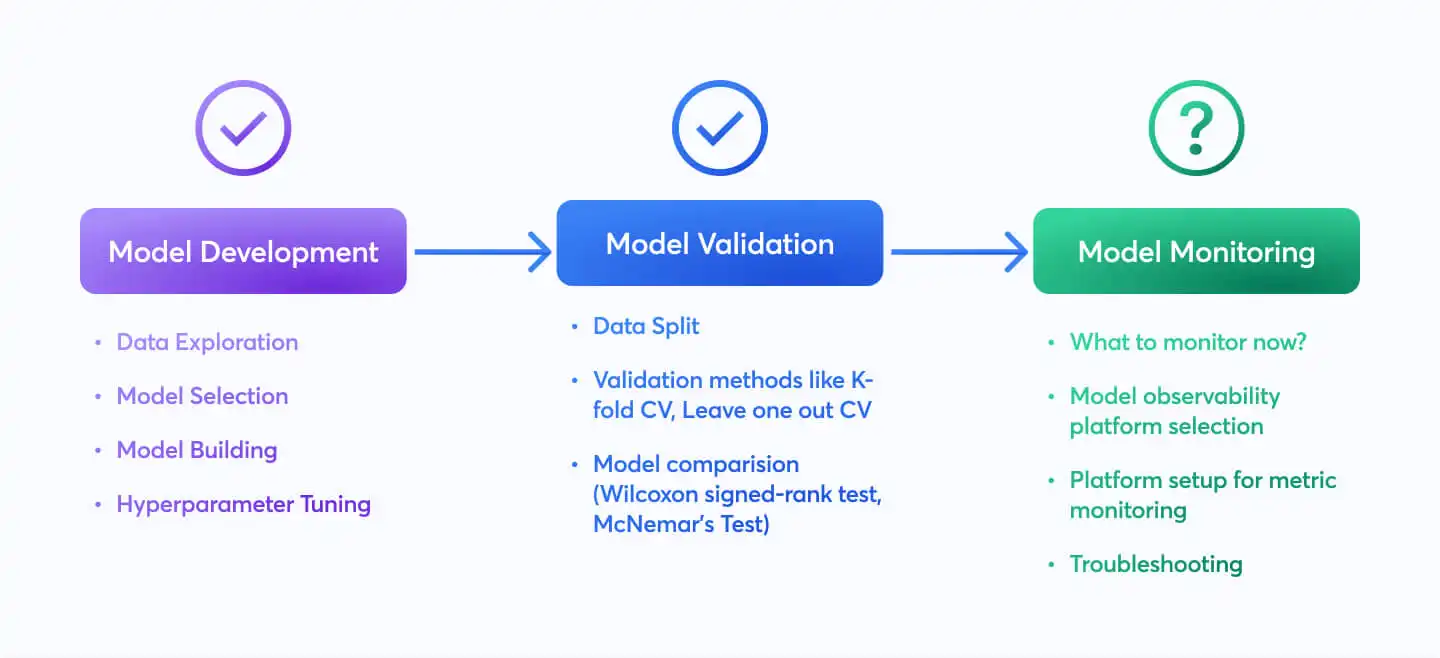Introduction
Are you facing issues in your business? Do you need a helping hand to solve business problems?
Machine learning development services help businesses tackle intricate issues.
This blog explains how to apply machine learning for accurate demand forecasting, customer retention, and fraud prevention.
We'll cover the crucial steps - collecting relevant data, preparing it through cleaning and preprocessing, and selecting the right algorithms. You'll learn evaluation metrics like accuracy and F1 score to assess model performance.
The blog also guides you through interpreting results, identifying influential features, and extracting actionable insights.
Best practices are shared to overcome hurdles like data bias and overfitting. With simple language and examples, you'll understand how machine learning development services drive data-driven decision-making.
Let us start the blog by understanding business problems.
Understanding Business Problems

Before applying machine learning, it is crucial to understand the specific business problem.
This section will discuss the importance of grasping the problem before adopting machine learning development services.
Identifying and Analyzing Business Problems
To effectively implement machine learning, it is essential to identify and analyze the business problem thoroughly. This involves examining the underlying factors, data availability, and the feasibility of applying machine learning algorithms.
Understanding the problem can help determine whether machine learning is the right approach or if other methods may be more suitable.
Examples of Business Problems
Here are a few examples of common business problems that can benefit from machine learning:
Demand Forecasting: Machine learning can be used to predict demand patterns, optimizing inventory management and production planning.
Customer Churn Prediction: By analyzing customer behavior data, machine learning models can identify signs of potential churn, allowing businesses to take proactive retention measures.
Fraud Detection: Machine learning algorithms can detect suspicious transaction patterns, preventing fraud and mitigating financial risks.
Next, we will cover how machine learning development services help collect and prepare data.
Data Collection and Preparation for Machine Learning Development
Data forms the backbone of machine learning models. This section will explore the significance of data in machine learning, how to collect relevant data, and discuss data quality and preprocessing techniques.
Importance of Data

Data acts as the fuel for machine learning algorithms. It provides the foundation for training accurate models and making reliable predictions.
Collecting and utilizing relevant data is crucial for successful machine learning development.
Collecting Relevant Data
Identifying the necessary data sources is the first step in collecting relevant data. This can include existing databases, web scraping, or integrating external datasets.
Focusing on data that aligns with the specific business problem and the desired outcomes is essential.
Data Quality and Preprocessing
To ensure the data is suitable for machine learning algorithms. This includes addressing missing values, handling outliers, and addressing data inconsistencies.
Preprocessing techniques such as data cleaning, normalization, and feature engineering are essential steps to enhance the quality and usability of the data.
Tips for Data Cleaning and Preprocessing
Here are few tips for data cleaning and preprocessing:
Remove duplicate entries and irrelevant data to minimize noise and improve accuracy.
Normalize numerical data to a standard scale to ensure fair comparisons.
Encode categorical variables into numerical representations suitable for machine learning algorithms.
Perform feature engineering to extract meaningful insights and create informative features.
Next, we will see how to choose and implement machine learning algorithms.
Choosing and Implementing Machine Learning Algorithms

When it comes to applying machine learning development services, choosing the right algorithm is crucial.
This section will introduce different types of machine learning algorithms, highlight considerations for algorithm selection based on the business problem, and discuss the implementation process, including model training, validation, and testing.
Different Types of Machine Learning Algorithms
Machine learning algorithms are divided into several types:
Classification: This algorithm categorizes data into predefined classes or labels. It is commonly employed for tasks like spam detection or sentiment analysis.
Regression: Regression algorithms are used when the goal is to predict a continuous value, such as sales figures or housing prices. They establish relationships between input variables and the expected output.
Clustering: Clustering algorithms group similar data points together based on their inherent patterns or similarities. This technique helps identify unknown patterns or discover potential segments within data.
Dimensionality Reduction: These algorithms reduce the number of input variables by transforming the data into a lower-dimensional representation while preserving the most essential information. They are useful for visualizations or when dealing with high-dimensional data.
Suggested Reading:
Why Machine Learning Development is Pivotal for Your Business?
Considerations for Algorithm Selection
Selecting the most appropriate algorithm depends on several factors:
Problem Type: Understand the nature of the problem at hand – whether it requires classification, regression, or clustering. This will help narrow down the choice of algorithms.
Data Availability: Assess the available data and its characteristics, such as the size, type, and quality. Certain algorithms may better suit large datasets, while others may perform well with smaller, more structured datasets.
Interpretability: Consider the interpretability of the algorithm. Some models, like decision trees, offer more transparency, allowing humans to understand the reasoning behind predictions.
Implementation Process
Implementing machine learning algorithms involves several steps:
Model Training: Use labeled or annotated data to train the algorithm. This consists in feeding the data into the algorithm and enabling it to learn patterns and relationships between the input features and the target variable.
Model Validation: Validate the trained model to ensure it performs well on unseen data. This is done using a separate validation dataset and evaluating the model's performance metrics, such as accuracy or mean squared error.
Model Testing: After validation, test the model's performance on an utterly unseen dataset. This determines how well the model can generalize and make accurate predictions based on new data.
Iteration and Improvement: Iterate the model by adjusting or trying different algorithms to improve performance. This could involve feature selection, hyperparameter tuning, or ensemble techniques.
Next, we will cover how to evaluate and interpret results with machine learning development.
Evaluating and Interpreting Results for Machine Learning Development

Once machine learning models are trained, evaluating their performance and interpreting the results are crucial.
This section will provide a guide on evaluating model performance using metrics such as accuracy, precision, and recall. It will also explain techniques for interpreting the results and discuss their practical implications in solving business problems.
Evaluating Model Performance
To assess the effectiveness of machine learning models, it is essential to use appropriate evaluation metrics.
Here are some standard metrics:
Accuracy: Measures the proportion of correct predictions over the total number of predictions. It is suitable for balanced data sets but can be misleading for imbalanced classes.
Precision: Evaluates the ability of the model to correctly identify positive instances out of all instances predicted as positive. It is particularly useful when false positives have significant consequences.
Recall: Measures the ability of the motor to identify positive instances out of all actual positive instances correctly. It is important when false negatives have significant consequences.
F1 Score: Combines precision and recall into a single metric to provide a balanced evaluation. It is useful when the dataset is imbalanced.
Interpreting the Results
Interpreting the results of machine learning models helps derive actionable insights and understand the practical implications for solving business problems.
Here are some techniques for interpreting results:
Feature Importance: Identify the importance of different input features in contributing to the model's predictions. This helps in understanding which factors are influential for decision-making.
Model Visualization: Visualize the model's internal workings, such as decision trees or decision boundaries, to gain insights into how it makes predictions. This provides transparency and builds trust in the model.
Prediction Explanations: Generate explanations for individual predictions, highlighting the features or factors that contributed the most. This helps explain the model's reasoning to stakeholders.
A/B Testing: Conduct experiments where different versions of the model or its predictions are compared, allowing for insights into the impact of changes and the model's performance.
Now, if you want to begin with machine learning development to enhance your customer service but have no clue about how to do it, then check out the NO-CODE chatbot platform, named BotPenguin.
With all the heavy work of chatbot development already done for you, BotPenguin allows users to integrate some of the prominent language models like GPT 4, Google PaLM, and Anthropic Claude to create chatbots that are powered by machine learning for platforms like:
Practical Implications
Interpreting the results of machine learning models has practical implications for solving business problems. It allows businesses to:
Make informed decisions: By understanding the factors influencing the model's predictions, businesses can make more informed and data-driven decisions.
Identify actionable insights: Interpreting the model results helps uncover patterns and relationships that can be used to drive actionable insights and improvements.
Improve customer experience: By understanding the reasons behind predictions, businesses can customize their offerings and improve the overall customer experience.
Next, we will cover how to overcome the challenges and pitfalls of machine learning development.
Overcoming Challenges and Pitfalls with Machine Learning Development
Developing machine learning development services for business problems involves challenges and potential pitfalls.
This section will discuss common challenges such as data bias, overfitting, and lack of interpretability. It will also provide strategies and best practices for overcoming these challenges, ensuring successful machine learning implementation.
Common Challenges
The common challenges are the following:
Data Bias: Biased data can lead to biased predictions and unfair results. Identifying and mitigating bias in the d is important, ensuring that the model treats all groups fairly.
Overfitting: Overfitting occurs when a model performs well on training data but fails to generalize to unseen data. Techniques like regularization and cross-validation can help combat overfitting.
Lack of Interpretability: Some machine learning algorithms, like deep learning models, can be challenging to interpret. This lack of interpretability may hinder trust and adoption. Techniques like model visualization and prediction explanations can address this challenge.
Suggested Reading:
Machine Learning Development: Trends and Predictions
Strategies to Overcome Challenges
To overcome those challenges, here are few strategies:
Data Preprocessing: Thoroughly clean and preprocess the data, addressing missing values, outliers, and inconsistencies. Ensure representative and unbiased data by carefully selecting the training dataset.
Feature Engineering: Involve and create informative features contributing to the model's performance. This process involves transforming and combining existing features to enhance predictive power.
Regularization Techniques: Apply regularization methods, such as L1 or L2 regularization, to prevent overfitting and improve model's generalization capabilities model.
Cross-Validation: Implement cross-validation techniques, such as k-fold cross-validation, to more accurately assess model performance and detect overfitting.
Ensemble Learning: Combine multiple machine learning models to take advantage of diverse perspectives and improve overall performance. Techniques like bagging, boosting, and stacking can be used for ensemble learning.
Best Practices For Machine Learning Development
In this section, you’ll find the best practices for machine learning development:
Transparent Documentation
Keep detailed records of the machine learning process, including data preprocessing steps, feature engineering, model selection, and hyperparameter tuning.
This helps ensure reproducibility and transparency.
Continuous Model Monitoring

Monitor the performance of the deployed model over time and regularly evaluate its effectiveness.
This allows for prompt identification and mitigation of potential issues.
Ethical Considerations
Pay attention to ethical considerations and potential biases in the data or model outcomes. Regularly evaluate and mitigate bias to ensure fairness and social responsibility.
By understanding and addressing common challenges like data bias, overfitting, and lack of interpretability, businesses can overcome hurdles and implement successful machine learning development services that provide accurate predictions and drive actionable insights.
Conclusion
Machine learning is a game-changer for businesses seeking efficiency and growth.
This blog has provided a guide to implementing machine learning development services successfully. From understanding business problems to collecting relevant data and choosing suitable algorithms, you now have the tools to drive informed decisions.
It is how to identify and analyze business problems to determine their continuity for machine learning. And provide examples of common business problems that can be solved using this approach.
By understanding the significance of data and following appropriate data collection and preparation techniques, businesses can lay a solid foundation for successful machine learning development projects.
Do not let challenges like data bias or overfitting hinder your progress. Follow the best practices outlined, such as transparent documentation and ethical considerations, to build trustworthy and fair models.
Use machine learning to optimize operations, enhance customer experiences, and gain a competitive edge. Your business's future lies in the power of data-driven insights.
Take the leap today!
Frequently Asked Questions (FAQs)
How can machine learning development enhance decision-making in business?
Machine learning development services enables data-driven decision-making by analyzing patterns and trends, providing valuable insights. This leads to more informed and strategic choices, optimizing business processes and improving overall efficiency.
What are the key steps in implementing machine learning solutions for business problems?
Implementing machine learning involves defining objectives, collecting relevant data, choosing appropriate algorithms, training models, and continuously refining them for optimal performance.
What role does machine learning play in customer relationship management (CRM)?
Machine learning in CRM helps businesses analyze customer behavior, predict preferences, and personalize interactions. This leads to improved customer satisfaction, loyalty, and a more effective customer engagement strategy.
How can machine learning support marketing strategies for businesses?
Machine learning enhances marketing by analyzing customer behavior, predicting trends, and optimizing advertising campaigns. This results in more targeted and effective marketing strategies, ultimately improving the return on investment.


